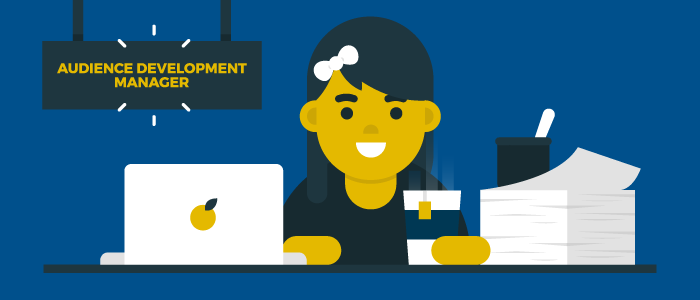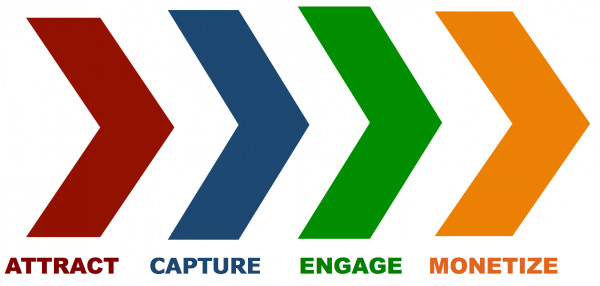
Audience development is the top of your website funnel – then all you have to do is convert, engage, and monetize them!
Imagine you own a landscaping company. You cut lawns, trim shrubs, design landscapes, and you even shovel in the winter.
Now imagine you throw a dinner party where your brother brings home his new girlfriend. This is the tenth girl in 10 years who has sat at your dinner table, so you assume that you may never see the lovely woman again who we’ll call Sarah.
After dinner, Sarah mentions that she just bought a house and the yard is just awful.
So there you are, with a potential customer in your house. What do you do?
A smart business owner would begin to develop a relationship with her. You ask about the yard, she tells you all the intricacies, you try to educate her on loam and gravel and her rare shrubs. She’s there, she thinks you’re smart, you have a solution to her problem, and she’ll probably answer the phone if you ask for her number in order to give her a quote.
So, do you ask?
This is not far off from what audience development looks like online.
- Someone sees you online for the first time, whether it’s in social media or on your website. If they leave, you may never see them again.
- You offer them good quality information, whether through a link, or through an article they found in search.
- Then, you ask for their email address, so that at some point, you can sell them something.
This might be the brash way to put it, but publishers don’t give away hundreds of thousands of words for fun. We do it so that we can build lists of loyal customers, who we’ll continue to serve free content in the hopes that one day they’ll buy something. And they often do.
[text_ad]
Audience Development Strategies
So, what is audience development? It’s the strategies used to build an audience, specifically online. Often, it’s the creation of new content in order to succeed in the four major sources of website traffic: search, social, referral and legacy.
Starting from the layer with the most visibility, we attract website visitors through search, then, a smaller number of those who we attract we will be able to capture their email addresses. We will then engage a smaller number of those captured subscribers with great content in order to keep them happy, and then make money doing so by monetizing the relationship and turning those engaged email subscribers into buyers. This is the smallest number of people, however, is fueled by the layers before it.

An audience development portal is populated by content that’s aligned with the services or products you ultimately want to sell. Most of our clients are selling magazines, books, videos, subscriptions, events, or other information products.
While audience development can be used to sell pretty much anything, it works best when selling information products because those products can be used to create the content for your audience development portal.
The first step in any good content driven audience development plan is to be very specific about the products you’re going to sell and the topics those products will cover. These topics for keyword phrases will form the backbone or taxonomy of your audience development portal and the first part of your audience development plan.
How publishers build an audience

The four trackable ways a publisher builds an audience goes into four buckets: search, social, referral, and legacy.
Search: The largest portion of your website traffic will come from search. For a Mequoda System publisher, maybe 80% or even higher. Well-written content that’s been optimized for search will ensure that you continue to get traffic to your website in massive quantities.
- Targeted? Yes. A reader that comes to your website looking for an answer to your question, and depending on how tightly focused you’ve SEO’d your articles, this reader is likely to be the most targeted there is.
Social: A smaller portion of your website traffic, although it still will be a massive portion, is social. This is your effort on Twitter, Facebook, LinkedIn, and anywhere else your content is shared.
- Targeted? Sometimes. This reader may be very targeted or not at all. Traffic that comes from the loyal following you’ve built in social media may be very targeted, but those who come from re-Tweets and shares may not be at all; that’s why conversion rates on social media are so mixed.
Referral: Next in line is an inbound link from another website. You wrote a post on their blog and linked back to yourself, or you published a post on your own blog and someone linked to you. Either way, this person is coming from someone else’s website, which you have no control over. On that note, these links are very valuable to Search, so you want more referrals.
- Targeted? No. This reader is the most untargeted of all, since you don’t control the content they came in on.
Legacy: This is the brand traffic that you receive, either by someone who already knows you, or subscribes to you. It could be a person who came by typing in your address from memory, or from a blow-in card in your magazine. This reader is easy to upsell to product if they’ve already been upsold to become a subscriber.
- Targeted? Yes. This reader may already be a subscriber.
Audience development is dependent on online editors and an array of content producers – including event producers, app producers, and product producers. The major benefit of audience development in a publishing company is that there is plenty of content to spread around. Big box stores tend to fail online when it comes to Search, Social, and Referrals unless they start building content – an asset you have coming out of your ears.
What is audience development? Everything you do to get people to your website, on your email list, and into your “best customers” luxury box.
Are you satisfied with your audience development efforts? How can we help you do it better? Let us know in the comments.
Editor’s note: This article was originally published in 2014 and has been updated.



Not directly mentioned but what for me is always a consideration in any audience attraction program is to find people who are so delighted with your products they share them with their like-interested friends–which according to most of the research is an increasingly important factor in purchase decisions and why the social and commerce sites are full of comments and reviews.
And I’m also looking for repeat purchases. The first order is often a trial purchase–did it deliver as promised, was it worth what I paid? Those who make a second purchase have a dramatically greater LTV to your company for most any market. If you have lots of one-time only buyers you probably have a challenging business.